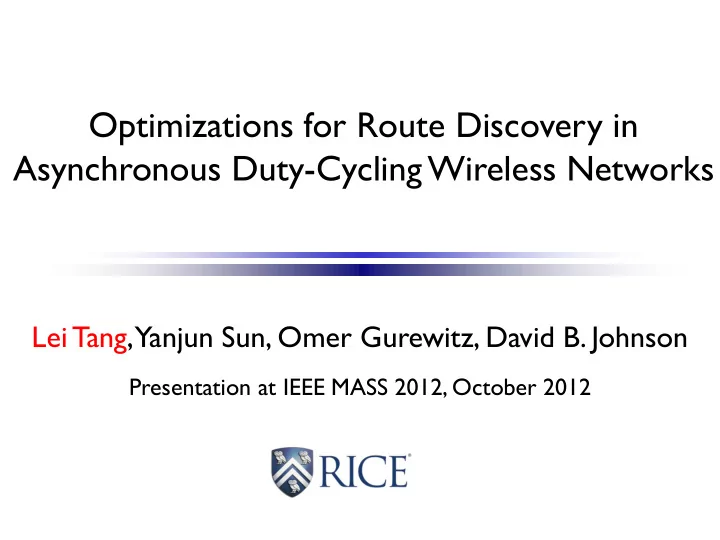

Optimizations for Route Discovery in Asynchronous Duty-Cycling Wireless Networks Lei Tang, Yanjun Sun, Omer Gurewitz, David B. Johnson Presentation at IEEE MASS 2012, October 2012
Asynchronous duty cycling MAC • Asynchronous duty cycling: reduces energy consumption and collisions. • Receiver-initiated, e.g., RI-MAC, PW-MAC, A-MAC. active sleep But causes poor on-demand route discovery results. 2
On-demand route discovery An example illustrating that, in asynchronous duty- cycling network, conventional routing protocol discovers a route longer than the shortest route. 5 6 7 1 2 3 4 3
On-demand route discovery Owing to random wakeup timings, in this example among all neighbors of source node 1, node 2 is the first neighbor waking up. Thus, Route Request is forwarded to 2. 5 6 7 1 {1} 2 3 4 4
On-demand route discovery Similarly, Route Request is forwarded from 2 to 3 when 3 wakes up. 5 6 7 1 {1} {1, 2} 2 3 4 5
On-demand route discovery Then, Route Request is forwarded from 3 to 4. 5 6 7 1 {1} {1, 2} {1, 2, 3} 2 3 4 6
On-demand route discovery Then, Route Request is forwarded from 4 to 6. 5 6 7 1 {1} {1, 2, 3, 4} {1, 2} {1, 2, 3} 2 3 4 7
On-demand route discovery The destination receives the first Route Request. {1, 2, 3, 4,6} 5 6 7 1 {1} {1, 2, 3, 4} {1, 2} {1, 2, 3} 2 3 4 8
On-demand route discovery Finally, node 5 wakes up and receives a Route Request. {1, 2, 3, 4,6} 5 6 7 {1} 1 {1} {1, 2, 3, 4} {1, 2} {1, 2, 3} 2 3 4 9
On-demand route discovery But node 6 will not forward the Route Request from node 5 because a node only forwards the first Route Request received. So the 5-hop route is discovered, rather than the 3-hop route. {1, 2, 3, 4,6} {1, 5} 5 6 7 {1} 1 {1} {1, 2, 3, 4} {1, 2} {1, 2, 3} 2 3 4 10
On-demand route discovery How serious is the problem? Random networks: 53% longer than optimal shortest. {1, 2, 3, 4,6} {1, 5} 5 6 7 {1} 1 {1} {1, 2, 3, 4} {1, 2} {1, 2, 3} 2 3 4 11
Our objective Improve the quality of the routes discovered. Our four optimization techniques: – Fully distributed. – Work on different route metrics, such as hop-count and ETX. – Simple and no extra routing messages. – Can be used independently or in combinations. 12
Optimization 1: Delayed Selection Shorter route may travel slower destination source 13
Optimization 1: Delayed Selection Wait for shorter routes; only forward the shortest destination source 14
Computing earliest Route Request forwarding time Received a Route Request k hops from source … … source hop 1 hop 2 hop k forwarder … … … There may be hop 1 hop k-1 a (k-1)-hop route Do not forward Route Request before: (k-1) × maxWakeupInterval – cumulativePacketBufferingTime 15
Optimization 2: Duty-Cycled Selection neighbor neighbor Request {s, x, y, t} Request {s, z, f} … … Request {s, z} Request {s, z, f} neighbor Forwarder f neighbor … … neighbor Request {s, w, u, q} Request {s, z, f} neighbor • Each node wakes up once per cycle to receive. • May receive more than one packet in one wakeup. • Forward only the shortest Route Request when done. 16
Optimization 3: Reply Updating wake@600 wake@620 M N S Forwarder F Q D P wake@670 original Route Reply: {S, M, N, F, Q, D} 17
Optimization 3: Reply Updating wake@600 wake@620 M N S Forwarder F Q D P wake@670 original Route Reply: {S, M, N, F, Q, D} update Route Reply to say: {S, P , F, Q, D} Each forwarder updates the route in Route Reply packet with the best known route. 18
Optimization 4: Adaptive Backoff shorter MAC backoff shorter Request {s, z} neighbor forwarder longer MAC backoff neighbor longer Request {s, w, u, q} Compute MAC backoffs to prioritize best route first: • Shortest route first (for hop count h ): CW – e.g., backoff( h ) = (min( ,10) h r and % CW ) slotTime 10 • Or, e.g., best-ETX route first. 19
Evaluation Extensive ns-2 simulations. Random networks with 100 nodes in (1000m × 1000m). – Dense: each node has on average 15.6 neighbors. Grid network with 100 nodes. – Sparse: each node has on average 3.6 neighbors. Evaluation metrics: – Route hop-length. – Route ETX. – Route discovery latency. – Node energy consumption (i.e., duty cycle). 20
Route length in random networks No-optimization: 53% longer Our optimizations: 0.2% longer 21
Route discovery latency in random networks Our optimizations reduced the route discovery latency 22
Node duty cycle in random networks Our optimizations slightly reduced route discovery node energy consumption. 23
Conclusion Four route discovery optimizations: – Fully distributed. – Work on different route metrics, such as hop-count and ETX. – Simple and no extra routing messages. – Can be used independently or in combinations. In the evaluations, these optimizations: – Significantly improved the routes discovered. – Reduced route discovery latency and energy consumption. 24
Recommend
More recommend